|
|
Post by hydraheadhunter on Mar 16, 2021 16:33:11 GMT
As cipher lets you cast spells without paying their mana cost, you can also add additional costs to cast the spell; similar to buyback costs being balanced by including non-mana resources like life, cards in hand, creatures, etc.  | Slaugthering Spree [sic]
A generic, a black, and a red
Sorcery
As an additional cost to cast this spell, sacrifice a creature.
Destroy target creature, then deal 1 damage to target opponent
for each creature that died this turn.
Cipher (Then you may exile this spell card encoded on a creature
you control. Whenever that creature deals combat damage to
a player, its controller may cast a copy of the encoded card
without paying its mana cost.)
Art by just-Rascal |
Noticed a typo: too unbothered to fix it. |
|
|
|
Post by ameisenmeister on Mar 16, 2021 16:43:43 GMT
As cipher lets you cast spells without paying their mana cost, you can also add additional costs to cast the spell; similar to buyback costs being balanced by including non-mana resources like life, cards in hand, creatures, etc. Cool idea! You could also do stuff like discard any number of cards to make it more variable and still keep it balanced. |
|
|
|
Post by ameisenmeister on Mar 22, 2021 13:20:52 GMT
Mechanic #6: Graft
When I looked through the storm scale to find mechanics for this thread, I was very surprised to see that the original Ravnica's block Simic keyword was actually an 8. Especially as I thought that graft was definitely one of the better mechanics of the whole block.
However, apparently not many people agreed with me on this point when giving feedback to wotc, because in his Ravnica storm scale article MaRo makes it clear that the unpopularity of graft is its biggest flaw. As you all probably are die-hard fans of this thread to a point where you almost learned each of my divine teachings by heart, you know already that unpopularity of a mechanic often has little to do with the mechanic itself. I am going to argue that graft is not a bad mechanic but actually a very interesting and versatile one, that sadly fell victim to the time it was printed as well as to uninspired and timid design.
Let's first look at what graft offers already as a mechanic and what design possibilities it has.
First of, graft opens up a lot of space for +1/+1 counter shenanigans with counters getting moved around all over the place. There are a lot of players who enjoy all the things that +1/+1 counters can do: giving a creature new abilities by something like Crowned Ceratok, having effects that double or move counters around, proliferating counters, and of course just throwing a load of +1/+1 counters onto a single creature and going to town.
Graft can be used for all of these things which already makes it unique among the counters matter keywords and already opens up a vast design space that neither adapt, proliferate nor outlast can fill.
Therefore, graft synergizes with basically all the things that work with any +1/+1 counter mechanic. Additionally, graft can be used for other tricks as well. You can use a creature as an early game threat of utility guy and dispose it later to buff or activate a new creature. Simic Initiate probably tries to do this but is really, really lame. In my example cards, I am going to show examples of how to play into this aspect much better.
Another thing that graft can do is creating pseudo combat tricks with creatures entering the battlefield at instant speed. This can be done with flash as well as by flickering creatures or simply creating tokens.
And last but not least, graft can be combined with death triggers of all kind and also get special death triggers. See my example cards in the end of this post.
But what was the problem with graft's first and only appearance in Dissension? Well, first and foremost it was the same problem that also hit tribute, formidable and a lot of other mechanics that haven't even talked about yet: it premiered in the third set of its block. Wotc has long realized the many problems that three-set-blocks bring and changed their policy. This is the unfortunate time graft was designed into I talked about in my entry.
The second and more severe issue is the lackluster design that accompanied the mechanic. Most of the graft creatures had an activated ability like “[cost]: Target creature with a +1/+1 counter on it gets something.” that could give other creatures (or themselves) a certain ability. This is a very clunky version of something that wotc did far better some years later. Helium Squirter looks and plays worse than both Sapphire Drake and Skatewing Spy and that's because Helium Squirter, just like Cytospawn Shambler, Aquastrand Spider and some others, tax yourself massively and repeatedly whenever you want to use them. Even assuming that these cards have an adequate power level, a slightly bigger one time investment would have worked wonders in terms of elegant play feel. So Helium Squirter should have probably costed just  more and grant all creatures with a +1/+1 counter flying regardless. more and grant all creatures with a +1/+1 counter flying regardless.
To sum it up, when using graft in a set, just stick to the following tips:
- Don't do three-set-blocks! It doesn't even matter whether you want to use graft. Just don't to them.
- Give the creatures immediate impact! No waiting until you untap or have mana or anything, at least not the majority of the time.
- Be creative! Although this is true for basically every mechanic – for every magic card, actually – it's especially true for graft as it has so many applications and offers so many strategies to go with.
So if you are even remotely into +1/+1 counter shenanigans or look for a cool keyword that plays into this direction, look no further than graft!
What do you think about it? Did I manage to raise your interest? Tell me in the comments.
PS: Next time, you are all in for a treat because the next essay will be something special. See you later!
|
|
jverse
3/3 Beast
  
Posts: 195
Favorite Card: Animar, Soul of Elements
Favorite Set: Shadowmoor
Color Alignment: Blue, Red, Green
|
Post by jverse on Mar 22, 2021 21:11:07 GMT
I also think graft has a lot of potential for creatures with abilities that remove +1/+1 counters as an activation cost. Something like Tap, Remove two +1/+1 counters from this creature: Target opponent sacrifices a creature. There is nothing limiting graft to creatures either. I've used it on custom lands and artifacts as well.
|
|
|
|
Post by gamma3 on Mar 25, 2021 21:36:43 GMT
I also think graft has a lot of potential for creatures with abilities that remove +1/+1 counters as an activation cost. Something like Tap, Remove two +1/+1 counters from this creature: Target opponent sacrifices a creature. There is nothing limiting graft to creatures either. I've used it on custom lands and artifacts as well. Graft did appear on a noncreature, in a cycle of uncommon monocolor taplands in future sight. |
|
foureyesisafish
7/7 Elemental
 
Posts: 386
Favorite Set: Ikoria: Lair of the Behemoths
Color Alignment: Blue, Red, Green
|
Post by foureyesisafish on Mar 26, 2021 12:18:22 GMT
I feel like graft is a great mechanic on its own. It just hasn't been used well yet.
...because come on, why doesn't graft has outlast-style "creatures with counters on them have X"? only thing close is Kraj.
|
|
|
|
Post by Daij_Djan on Mar 28, 2021 11:27:42 GMT
Yeah, I think Graft's biggest issue is the complicated setup for too little reward due to card design.. Llanowar Reborn wasn't in the original set, so excluding the land there only was one Graft card at mana value 1 and 2 each - while all other Graft cards had mana value 3 or higher. And you needed one of those creatures first, then afterwards play a creature you want to transfer the first counter to, and then even pay extra mana (not much, but still..) to get the additional effect? Talk about a big setup for small rewards.. PS: Next time, you are all in for a treat because the next essay will be something special. See you later!
Sounds interesting  |
|
|
|
Post by Daij_Djan on Mar 29, 2021 13:53:25 GMT
As you might have noticed two weeks ago, when ameisenmeister teased his upcoming article about how to redeem Cipher, both hydraheadhunter and myself originally expected it being Haunt's time to shine. As you can imagine I was very disappointed – but while I was still pondering about whether I should permaban ameisenmeister for his cruel betrayal, I suddenly received a message: ameisenmeister asked me whether I'd be interested in tackling the mechanic myself since I apparently had already put some thought into it anyway. Without hesitation I agreed to his proposal and put the banhammer aside (for now) – so here we go!(Just kidding of course. Massive thanks to ameisenmeister for offering me this chance!  )Mechanic #7: HauntHaunt was the original Ravnica block's Orzhov mechanic. Never to be used again, it exists on a mere ten cards total. To start things off, we'll lower that number down to the seven creature cards featuring it – while my suggested fix could technically be used for noncreatures as well, I'm not that big of a fan for it for flavor reasons also I don't want to constantly make sure my explanations fit both creatures and noncreatures. So to make things easier, let's pretend the three spell cards don't exist for the sake of this article )Mechanic #7: HauntHaunt was the original Ravnica block's Orzhov mechanic. Never to be used again, it exists on a mere ten cards total. To start things off, we'll lower that number down to the seven creature cards featuring it – while my suggested fix could technically be used for noncreatures as well, I'm not that big of a fan for it for flavor reasons also I don't want to constantly make sure my explanations fit both creatures and noncreatures. So to make things easier, let's pretend the three spell cards don't exist for the sake of this article  With this issue resolved, why exactly is Haunt a 9 on the Storm Scale? When we look at the official article, MaRo mentions two issues. The first complaint is the one I've heard being made quite a lot by others when the mechanic comes up in a discussion: „It's complicated.“ But here's the deal: It's really not. With this issue resolved, why exactly is Haunt a 9 on the Storm Scale? When we look at the official article, MaRo mentions two issues. The first complaint is the one I've heard being made quite a lot by others when the mechanic comes up in a discussion: „It's complicated.“ But here's the deal: It's really not.- Haunt (When this creature dies, exile it haunting target creature.)
That's all. It's simple, it's clean. Since when is imprinting on death considered complicated? No, I'd argue the issue lies elsewhere: The mechanic was used in an insanely convoluted way. You have creatures with en ETB effect, then have them, haunt a target on death, and when the target dies you finally get the original ETB effect again for a second time as your reward. Yeah, I can see players forgetting a trigger sometimes..Also is it me, or is this approach a massive flavor fail? To be honest, I'm not that much into horror / ghost movies - however last time I checked, when the cliché low-IQ female cheerleader protagonist gets haunted, the ghost messes with her constantly rather then just popping by on her deathbed just to say „hi!“ one final time.. Additionally, having to balance the triggers in a way you're fine with them happening twice was the second and final issue MaRo mentioned in the article.So how do we solve this? Well, if you've looked at the link I posted two weeks ago (or still remember a few of my old CotW entries), you already know the answer:My suggestion is treating haunting spirits basically like auras sitting in exile, think of like a reverse Bestow if you will. Similar to Bestow however, I do not suggest simply using any kind of effect to mess with the haunted creature – while you could do that, it would (a) feel rather messy imho and (b) will most likely be hard to remeber well. So the way I see it, there are two options to do this well:- Give the creature a downside that gets „passed on“ to the haunted creature.
- Give the creature an upside that's reversed on the haunted creature.
To further avoid confusion, I'd suggest not being to messy with these two options at lower rarities: Like using the first approach for all common designs, the second for the uncommons – and then feel free to mix both at (mythic) rare. Also as a sidenote a small critique to my own design: As much as I like Geist of Blade's simplicity, the creature's normal and haunting abilities should probably always be seperated. So with all of this in mind, it's time for some more..So is this it, are we done here? Not quite. There are in fact two issues with my rework as well that should be brought up for the sake of fairness:The more obvious one that I have in fact been adressed with twice already is the lack of interactivity – these are basically impossible to remove auras after all. As such, there is some truth to this obviously (even though I'd argue aura removal almost never getting used anyway), but there are ways for all colors to deal with Haunt even without having to use brute force designs like WotC did to stop Suspend from getting out of control in Limited.White, sometimes black and red can directly exile creatures from the battlefield, preventing your spirits from being able to haunt a target in the first place. Additionally, white and black are both able to step in at the last second while the haunt trigger is still on the stack. Likewise green and blue have access to creatures with hexproof that cannot be haunted in the first place, just as both colors can use the ability as a one-off to protect their other creatures as well. And when none of this worked and your creature is already haunted, then white and blue can use a blink effect to exorzise the pesky spirit. Or blue, white and sometimes even green can bounce their own creature as a last resort.So yeah, all colors already have their own way to deal with my reworked Haunt if you think about it. This only leaves one last issue – which ironically I don't ever remember being brought up but I'm definitely aware of it: Haunting your own creatures. The one advantage the old design had was you didn't mind doing this (sometimes you even wanted to do this), but with my rework it can now become an issue. And while I personally don't mind it much (I like stuff not always being „all upside“ anyway  ), there would even be a fix to this if you want to go the extra mile: By adjusting the mechanic.No, I'm not talking about a complete rework like what WotC did with Companion, think more in the line of Flanking vs. Flanking or Proliferate vs. Proliferate. The fix here would be just as minor – simply add a „you may“ to the rules text.And with this, I'm finally done ranting. Haunt really is a pet peeve of mine, a mechanic I really think WotC did very dirty and which I hope will get redeemed someday. And fun fact: This might indeed happen sometime, because while researching for writing this I noticed MaRo has lowered Haunt on the Storm Scale to a mere 6 just recently. And what is the reason for this? Apparently Chris Mooney had the exact same idea for the GDS3. Hilarious! I honestly had no idea, till I decided to check this out after writing all of this at the last minute. So I guess this means an official redemption for Haunt similar to my suggestion actually is kind of possible.. Feel free to read what Chris did for Challenge #5 for additional input ), there would even be a fix to this if you want to go the extra mile: By adjusting the mechanic.No, I'm not talking about a complete rework like what WotC did with Companion, think more in the line of Flanking vs. Flanking or Proliferate vs. Proliferate. The fix here would be just as minor – simply add a „you may“ to the rules text.And with this, I'm finally done ranting. Haunt really is a pet peeve of mine, a mechanic I really think WotC did very dirty and which I hope will get redeemed someday. And fun fact: This might indeed happen sometime, because while researching for writing this I noticed MaRo has lowered Haunt on the Storm Scale to a mere 6 just recently. And what is the reason for this? Apparently Chris Mooney had the exact same idea for the GDS3. Hilarious! I honestly had no idea, till I decided to check this out after writing all of this at the last minute. So I guess this means an official redemption for Haunt similar to my suggestion actually is kind of possible.. Feel free to read what Chris did for Challenge #5 for additional input  But with that final addendum, that's all I have to say for today – for real this time But with that final addendum, that's all I have to say for today – for real this time  Hope you all enjoyed my rant and big thanks once more to ameisenmeister for giving me this opportunity. Bye! Hope you all enjoyed my rant and big thanks once more to ameisenmeister for giving me this opportunity. Bye!
|
|
jverse
3/3 Beast
  
Posts: 195
Favorite Card: Animar, Soul of Elements
Favorite Set: Shadowmoor
Color Alignment: Blue, Red, Green
|
Post by jverse on Mar 29, 2021 14:20:32 GMT
I'm really digging the reverse effect haunt cards. It makes total flavor sense and could lead to some really interesting interactions. I'm not sure why you are against separating the creature abilities and haunt abilities on other cards where the effect is the same, however. Wouldn't you want to cut down on text, or are you worried that the haunt ability will get overlooked?
|
|
|
|
Post by Daij_Djan on Mar 30, 2021 0:04:28 GMT
Glad you like the concept  Wouldn't you want to cut down on text, or are you worried that the haunt ability will get overlooked? That's mostly it, yeah. Funnily enough, if we would be talking about a single card like my Geist of Blades in a Masters set or similar, than I probably wouldn't mind much. But in the given context of a normal set (let's say in one of the upcoming Innistrad ones for example), I think mixing cards that require two seperate abilities with ones having only a single one could cause confusion - also I simply dislike it for the sake of consistency to be honest. |
|
|
|
Post by hydraheadhunter on Mar 30, 2021 5:59:15 GMT
I don't know how to feel about the way these cards are templated for this revamp. I know typically card abilities are printed in order of use so having haunt between the foo and fum would match the golden standard; but, it just feels icky to me having that short (without reminder text) line between two potentially long lines. Aesthetically, it feels like haunt cards would look better like: Name and Cost
Creature - Type Rarity
Haunt.
Foo while a creature.
Fum while haunting a creature.
P/T |
And, again I recognize that this deviates from the order of play standard. But it feels like it'd look a lot cleaner in most cases. |
|
|
|
Post by ameisenmeister on Mar 31, 2021 17:33:42 GMT
I like this rework of haunt and am, when it comes to templating, more on the side of Daij_Djan. The mirror effects are very cool, too! |
|
|
|
Post by ameisenmeister on Apr 12, 2021 20:49:46 GMT
Mechanic #7: InspiredThere are a lot of mechanics high on the storm scale that are just there because of bad design and low power level of individual cards. There are, however, also some mechanics that are inherently problematic, some being too broken to fix. And a very small fraction of mechanics indeed is problematic in itself but can still be saved by conscious design. Cipher is one example, inspired is another one, although for different reasons.
In his appropriate article, MaRo lists a lot of issues with the mechanic. According to him (and wotc's research), it's unpopular, problematic for development and also for some reason hard to track for many players.
I am going to argue that two of these problems are mainly caused by design decisions, and the remaining problem isn't really valid at all. So let's go! This is what MaRo has to say about inspired's popularity, and - as usual - I disagree not with the result but with the assumed reasons for it. Inspired being hard to track is a problem I'm going to adress in a second but I can tell you already that I'm pretty sure that it wasn't a big reason for people not to like the mechanic. Not being flavorful likely isn't a big factor either. Players like and love mechanics like cycling, flashback and landfall although they have basically no flavor at all. No, there are instead two other reasons for it's unpopularity - one of which can be fixed and one that's a bit harder. Let's begin with the second, because I'm going to speak about the first problem after the next paragraph. This is what MaRo has to say about inspired's popularity, and - as usual - I disagree not with the result but with the assumed reasons for it. Inspired being hard to track is a problem I'm going to adress in a second but I can tell you already that I'm pretty sure that it wasn't a big reason for people not to like the mechanic. Not being flavorful likely isn't a big factor either. Players like and love mechanics like cycling, flashback and landfall although they have basically no flavor at all. No, there are instead two other reasons for it's unpopularity - one of which can be fixed and one that's a bit harder. Let's begin with the second, because I'm going to speak about the first problem after the next paragraph.
Inspired needs set up, not necessarily in the form of other cards like ferociousdoes, but in the form of luck and a lot of time. Casting a creature, waiting a turn for it to attack, survive an attack and then survive your opponent(s)'s turns to eventually untap leaves a lot of room for feel bad moments, especially if your creature gets removed right before you're about to finally untap with it. My guess is that there were a lot of players experiencing this during their limited events of Born of the Gods and Journey into Nyx.
This issue is indeed hard to adress because the mechanic caring about untapping more or less implies these big open windows for your opponent messing with your plan. But maybe there is a solution after all...
MaRo adresses all the work you had to do to get your inspired creatures to trigger when he talks about development problems. Because of all the hoops players had to jump through, it was a lot of work put into making the mechanic relevant for constructed (which, to my knowledge, it never really was). And indeed, looking at the cards of Born of the Gods and Journey into Nyx, there were really a bunch of supporting cards. From the cheesy  auras like Evanescent Intellect and Ephara's Radiance over to ho-hum cards like Siren Song Lyre and Black Oak of Odunos to actually good stuff like Aqueous Form, Springleaf Drum or Kiora's Follower. auras like Evanescent Intellect and Ephara's Radiance over to ho-hum cards like Siren Song Lyre and Black Oak of Odunos to actually good stuff like Aqueous Form, Springleaf Drum or Kiora's Follower.
All in all, there were a lot of cards that gave you some tricks to get your inspired triggers if you just worked a bit for it. But this is were I see the problem with the general path design choose to walk on. Instead of making you jump through the hoops waiting for an attack - surviving the attack - surviving the opponent's turn to finally untap, they gave you an alternative set of hoops, namely waiting for the creature to be tappable - having some niche aura/equipment/ability ready - tapping the creature for a questionable gain - surviving the opponent's turn to finally untap.
I argue that wotc did a lot to allow for tap-untap-shenanigans. So much, actually, that they couldn't risk to actually print some good cards with inspired to make use of that. Theros block and its second and third set are infamous for their low power level, but the cards wth inspired tend to be weak even relative to most of the rest of the set.
Next to cards like Deepwater Hypnotist, God-Favored General and Warchanter of Mogis, even duds like Pheres-Band Tromper and Sphinx's Disciple look almost decent. And even the rares like Arbiter of the Ideal and King Macar are so wonky, they don't even read particularly interesting, much less powerful.
The solution here is actually pretty easy: less weird shenanigan cards and more powerful - and evasive! - creatures with inspired. Interestingly enough, I've got a good friend who runs a dedicated inspired deck with the main game plan to set up a lot of support cards that tap and untap stuff, then casting King Macar and praying that the opponent doesn't have a removal spell. The deck is really, really wonky but there's one card that actually pulls it's weight even without any support, and that's Siren of the Silent Song. While by no means a powerhouse, the evasion ability alone is sometimes enough to let it get trough once or twice, causing some disruption. Considering that the Siren only costs three mana makes it probably the most dangerous card in an all in all not very dangerous deck.
The fact that inspired is a creature based mechanic and cares about - eeeeeeew! - combat already kicks it far out of any competitive relevance, but you can still make a good limited and kitchen table mechanic out of it if you take cards like Siren of the Silent Song as a baseline. So let's sum up what the Siren brings to the table!
1. a rather cheap mana value (or converted mana cost if you please) of three
2. an evasion ability that makes it useful without supporting cards
3. a powerful inspired effect that's actually worth the trouble
Of course, not every card has to have all these boxes checked but perhaps at least two of them. This way you can design inspired cards that can stand on it's own and are merely pushed into powerful territory via supporting cards instead of being only playable with them.
Time to see what these ideas inspired me to come up with...So yeah, inspired is probably never going to be a crazy cool mechanic but it can deliver if designed right. What do you think about inspired and my thoughts about it?
|
|
|
|
Post by hydraheadhunter on Jun 26, 2021 21:30:00 GMT
It's been a bit since this saw a post, so I hope it's okay if I drop an essay uninvited.
Mechanic #9: RhysticThis post, like all bad things, was prompted by a twitter argument. In it some guy™ repeatedly says rhystic is inherently bad, and I repeatedly say that " Rhystic's not inherently bad: it's just that all the cards that were printed with rhystic were bad," and we don't really get anywhere in the discussion because they're more interested in twitting gotcha's than having an honest discussion. But anyway, let's get past the onus of the post to the actual content of the post. Rhystic sits at a 9 on the storm scale, and not only do I think it doesn't deserve this rating: I feel the rating is a blatent lie. Yes, we don't see any cards named " Rhystic" anymore but the rhystic mechanic still regularly see print. What do I mean by that: well, let's define Rhystic properly. Rhystic: Any effect which could follow the form, Foo unless your opponent pays [cost]. There are ~226 counter spells at time of posting: of them, 77 fit the above definition, with Lose Focus modern horizons 2 and Jwari Disruption|Jwari Ruins in the standard set Zendikar Rising. That's a third of all existing counterspells, and it includes recently printed spells. Are all of them good? No. But did they regularly see play in their standards and limited formats? Yes. The new deciduous keyword Ward is basically just ' rhystic hexproof,' and has existed unkeyworded as far back as Frost Titan's original printing in M11. Smothering Tithe is a rhystic effect rated twelvth on EDHrec at time of posting. Propaganda represents a family of rhystic effects that tax attacking. So what are the sins of the original rhystic spells that wrongly puts it so high on the storm scale. In my mind there are three large pitfalls they fall into mechanically, and one they fall into psychologically. - They don't do anything if your opponent pays the cost, putting you down a card (Rhystic Shield, Rhystic Syphon, Rhystic Tutor).
- They're annoying because they trigger too often (Rhystic Study, Mystic Remora).
- They're generally not very cost efficient (Rhystic deluge, Rhystic Lightning).
- The rhystic effect is perceived by players as a downside, making it unpopular.
- While I disagree with WotC's oops all upside mentality they do have a point that players don't tend to like mechanics that they perceive as downsides.
What can be done, and is being done, to recover the mechanic. Well, the first problem of the all or nothing nature of rhystic cards can be solved by letting the cards do something less powerful when the cost is paid: instead of Foo unless an opponent pays [cost] you'd have Foo unless an opponent pays [cost]. if they do, Fee. You see the prototype for this effect in Rhystic Lightning which deals 4 damage unless the cost is paid, in which case it only deals two. The problem is, it's heavily over costed: for three mana, I could cast three shocks, dealing more damage than either case. And this brings up the difficulty presented by balancing Rhystic spells: their strongest effect and weakest effect both need to be reasonable for the cost, but there needs to be enough difference between them for opponents to want to pay the cost. An alternative way of solving the first problem rhystic cards run into is by shrinking how much of the design space the rhystic effect takes up so that the card can do other things. Ward is the perfect example of this. By keywording a specific type of rhystic effect, the effect becomes less taxing on the design space, allowing cards to have effects outside of their rhystic ability. (Ward also manages to solve the other problems with rhystic but this isn't a post to gush about ward, it's a post about how the rhystic mechanic can be fixed in general). The second hiccup to a good rhystic card is triggering rhystic effects; they need to trigger often enough to be relevant, but not so often as to become annoying (are you paying the 1). The obvious way to do this is by choosing triggers which every deck will need to trigger, often multiple times a turn; that is don't trigger on casting spells, Rhystic Study: I don't want to pay the 1, but that doesn't mean I want you drawing a card. Smothering Tithe butts up against this line because every turn starts by drawing a card, but since that only happens once each turn by default, it's less painful than rhystic study which is liable to happen three or four times a turn. That ties into the other way you can resolve this potential problem with rhystic cards: limiting the number of times it triggers each turn. Let's skip over the third hiccup, which is just one of them boring balancing issues, to discuss the much more interesting point of player perception. Players are loss adverse: they don't like it when the stuff they've already paid for turns up in smoke, so a card that says 'hey, I might turn up in smoke if your opponent pays a cost,' has an uphill battle to not be seen in a negetive light. I promise this post wasn't for gushing about ward, but ward skillfully avoids this problem by turning the rhystic effect into card protection; smoking a warded card costs an opponent more. There's another way to acheive this effect though. The problem with using mana as the cost is that mana is an ephemeral resource that comes back each turn; designing rhystic effects that cost an opponent more permanent and interesting resources is a great way for players to see these cards as a net gain, even when the effect gets nullified because the rhystic cost got paid: simple resources like life, cards in hand, library, or graveyard and permanents in play make for great potential costs, as do stranger resources you don't typically think about as resources like turns and phases. Another solution to this is giving players control over how much their rhystic effects cost to upturn: this is very popular among the rhystic counter spells, having spell controllers pay X to save their spells. By giving players control over how much they invest, and how difficult it is to smoke their investment, it mitigates the potential feels bads. |
|
|
|
Post by hydraheadhunter on Dec 26, 2022 7:59:38 GMT
Hey, guess which idiot got in an agruement about whether Cumulative Upkeep is an inherently a bad mechanic or a mechanic with nothing but bad cards? Thats r— Mechanic #10: Cumulative Upkeep. Cumulative Upkeep [Cost]: At the beginning of your upkeep put an age counter on ~ then sacrifice it unless you pay [cost] for each age counter on it. ]Now, the only data point we have on where Cumulative Upkeep is a 2016 blog post by Rosewater where without explaination he says, " At this point, [It's] probably a 9." That doesn't give us a lot to go on as to why its so high on the list, but we can figure that the main problems with it are its nature as a downside mechanic, meaning it's unpopular when it's just tacked on to cards that're too good already bad. Like, was Balduvian Shaman really gonna do to warp a format if it didn't have cumulative upkeep pushing it's power level down? Probably not. But anyway, let's get into the meat of the mechanic. The point of cumulative upkeep as a mechanic is to give you a benefit in exchange for a cost you can't keep performing forever. The easiest way to do this is with mana, but actions that put a different kind of increasing strain on your resources or cause your opponent to gain an increasing large advantage are also effective and are where cumulative upkeep really shines. Let's set aside the option for cumulative upkeeps that force you to pay mana or life to focus on the weird costs, because cumulative upkeep does three very interesting things: - It provides space for actions that are normally considered effects to be undertaken as costs.
- It can make performing normally inconsequencial actions unmanagable
- It can make performing normal desirable actions undesirable.
{Cumulative Upkeep Cards with Unusual Costs} 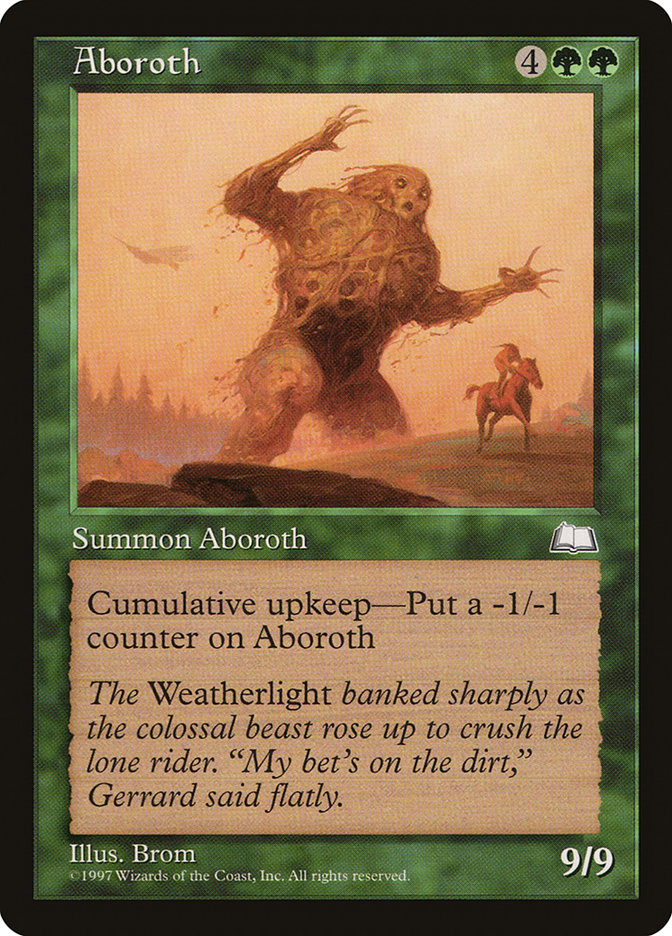 | Aboroth
{4}{G}{G}
Creature — Elemental
Cumulative upkeep—Put a -1/-1 counter on Aboroth.
The Weatherlight banked sharply as the colossal beast rose up to crush the lone rider. “My bet’s on the dirt,” Gerrard said flatly.
9/9
| Aboroth here is basically just vanishing 4 with different steps, but it cleanly demonstrates how quickly cumulative upkeep costs stack up when theyr well, cumulative.
One -1/-1 counter becomes three becomes six becomes ten and oops: Aboroth is dead Dave.
| 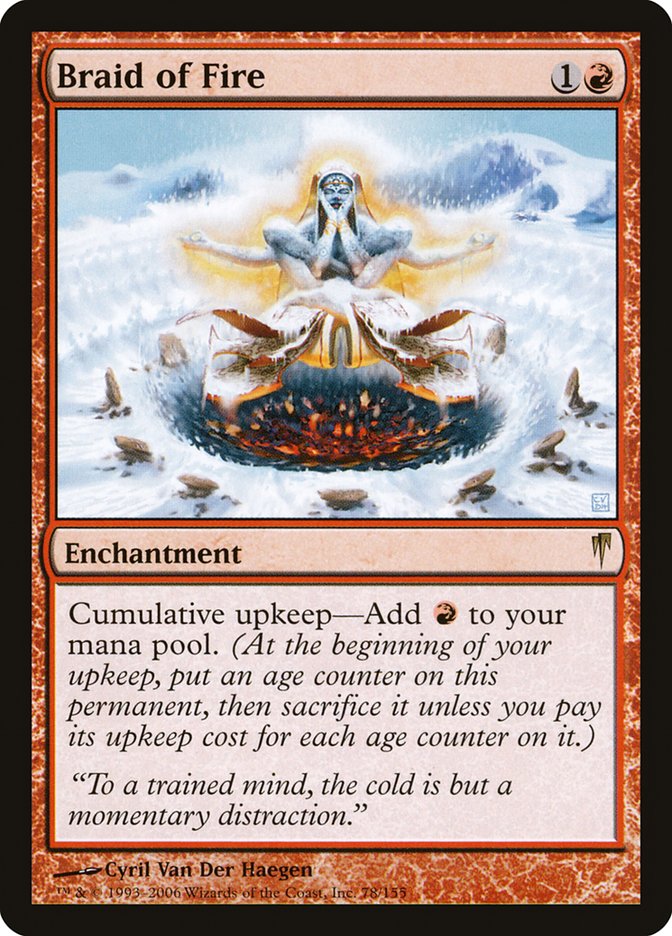 | Braid of Fire
{1}{R}
Enchantment
Cumulative upkeep—Add {R}.
“To a trained mind, the cold is but a momentary distraction.”
| Braid of Fire is an interesting card. The rulings itself call it "very unusual" as it does nothing but add red mana to your mana pool as a cost. Looking at the design, you'd likely think that it was printed when mana burn was a thing and that rule change fundementally shifted the card's identity, but no... Braid of fire was printed in coldsnap, long after sixth edition removed mana burn officially (but not before people (read: my uncle) stopped teaching it as a core mechanic of the game to new players (read:me)). It's just, like this.
| 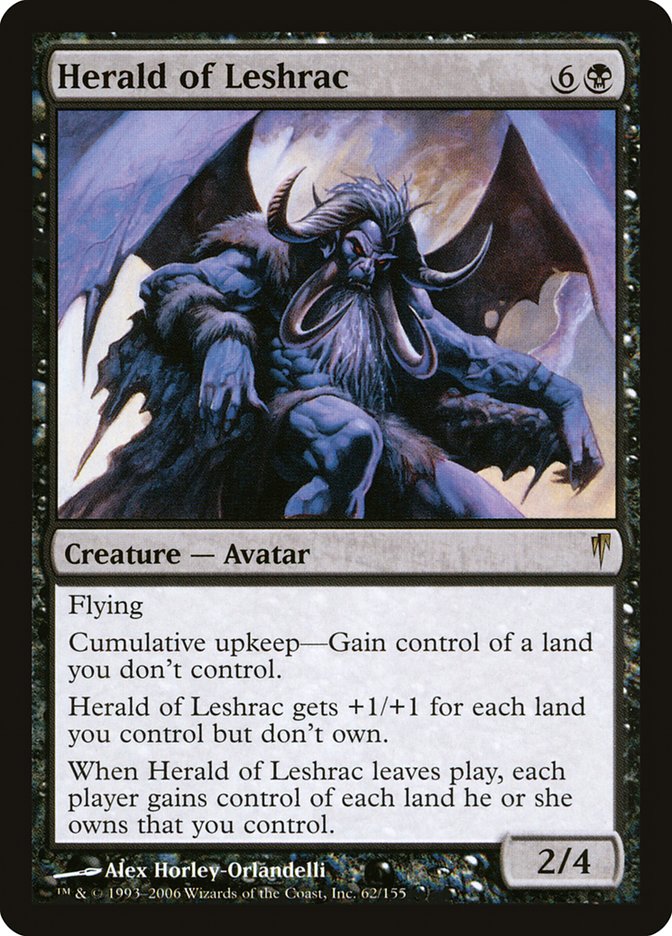 | Herald of Leshrac
{6}{B}
Creature — Avatar
Flying
Cumulative upkeep—Gain control of a land you don’t control.
Herald of Leshrac gets +1/+1 for each land you control but don’t own.
When Herald of Leshrac leaves the battlefield, each player gains control of each land they own that you control.
2/4
| Herald of Leshrac takes the principle demonstrated in Aboroth, that cumulation becomes big faster than you expect, and turns it up a notch, by making it an upside. in three turns, you'll have a six land advantage over your opponents, and in four turns it'll be ten lands.
Gaining control of lands each turn makes Leshrac a really potent piece for starting to stunlock your opponents: Throw stiffle on an isochron scepter and keep the lands for ever.
The problem is that he costs a lot and by the time you get him out, most games outside of commander are about to wrap up.
| 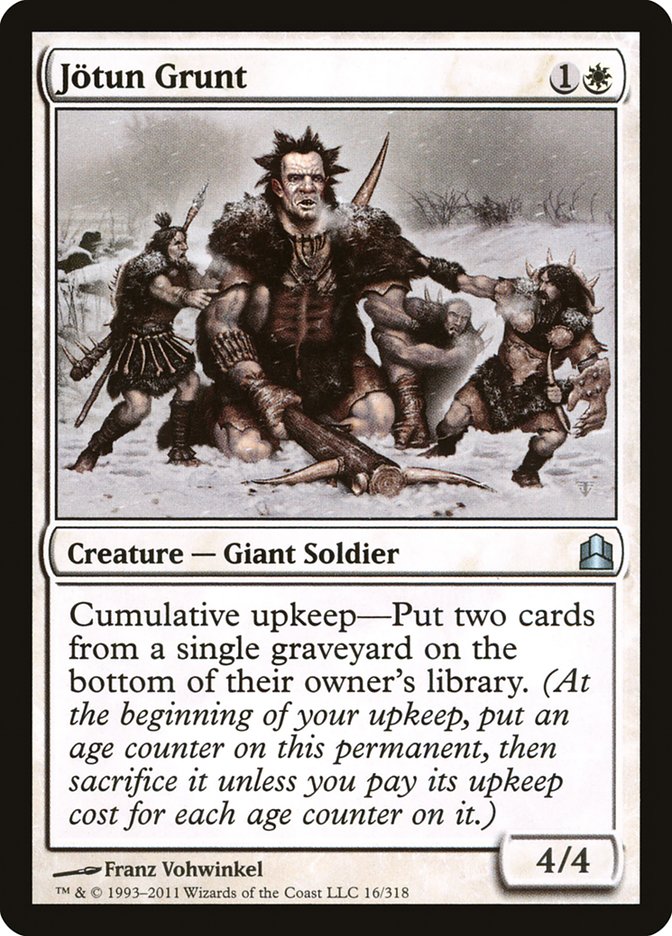 | Jötun Grunt
{1}{W}
Creature — Giant Soldier
Cumulative upkeep—Put two cards from a single graveyard on the bottom of their owner’s library.
4/4 | This is a fun one for anti-mill strategies that makes it difficult to mill out a player continuously putting their graveyard into their library and it's effective continuous graveyard hate against self-mill strategies.
| 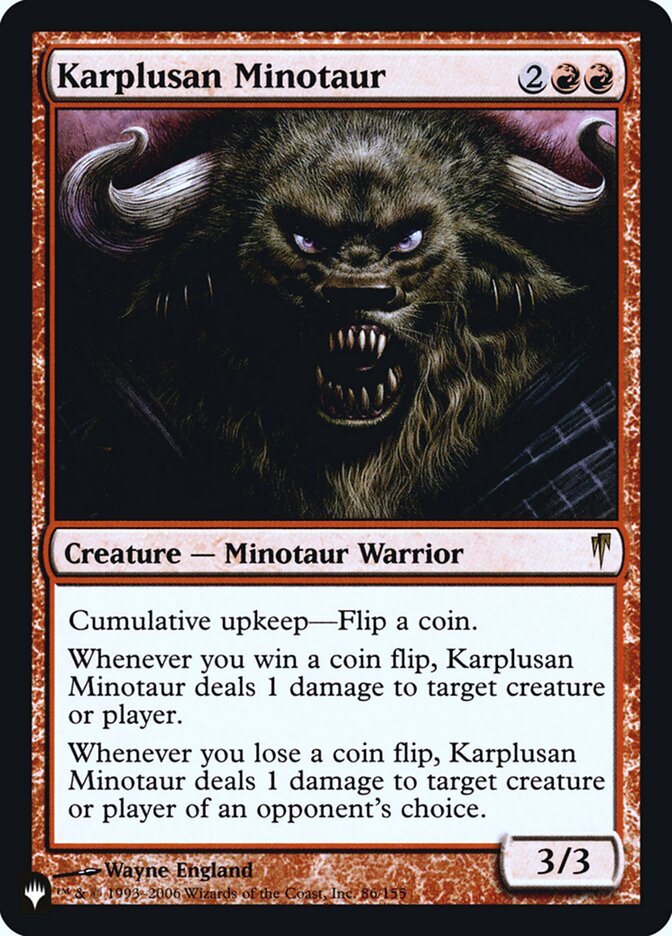 | Karplusan Minotaur
{2}{R}{R}
Creature — Minotaur Warrior
Cumulative upkeep—Flip a coin.
Whenever you win a coin flip, Karplusan Minotaur deals 1 damage to any target.
Whenever you lose a coin flip, Karplusan Minotaur deals 1 damage to any target of an opponent’s choice.
3/3 | The cumulative upkeep here is an increase in chaos. The number of times you win a flip compared to the number of times you'll lose one is variable but sits at about 50-50, meaning this guy can expect to stay around for 3 to 6 turns but can stay longer if the opponent doesn't choose him.
| 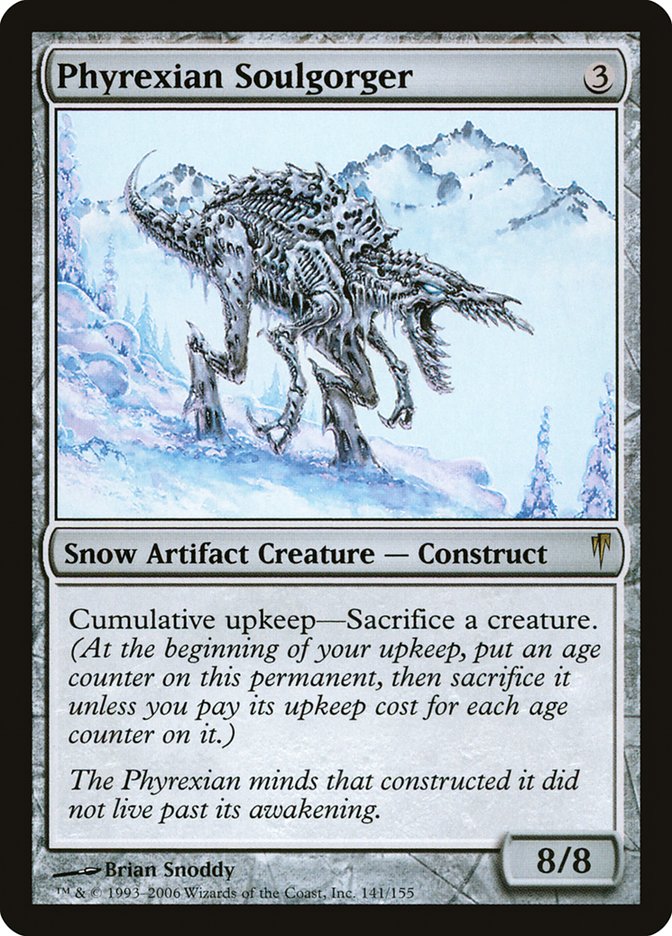 | Phyrexian Soulgorger
{3}
Snow Artifact Creature — Phyrexian Construct
Cumulative upkeep—Sacrifice a creature.
The Phyrexian minds that constructed it did not live past its awakening.
8/8 | Nice and simple demonstration of the Aboroth principle again: The amount you have to pay is going to outstrip your ability and desire to pay it eventually.
| 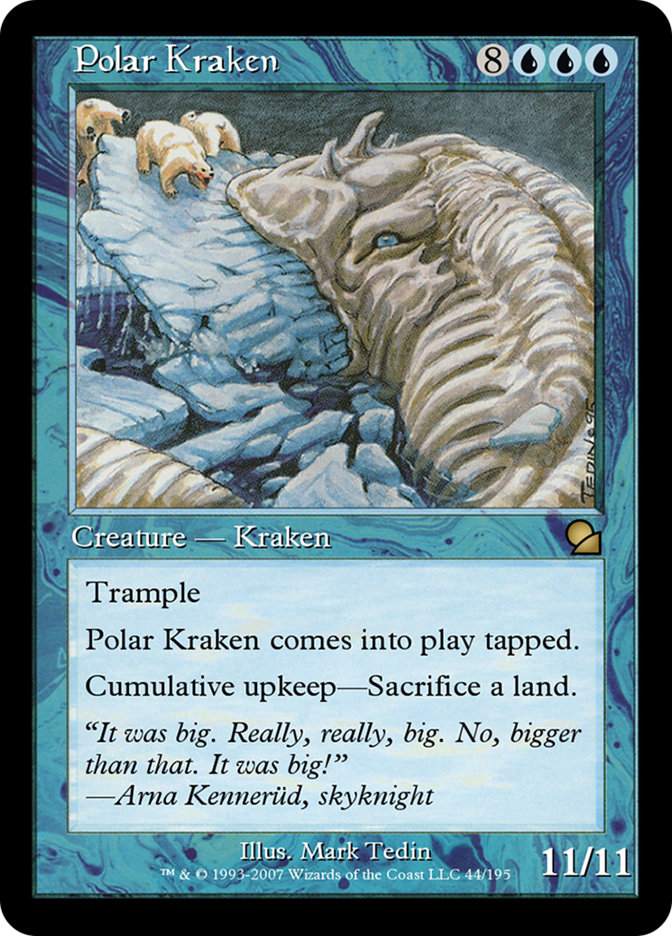
| Polar Kraken
{8}{U}{U}{U}
Creature — Kraken
Trample
Polar Kraken enters the battlefield tapped.
Cumulative upkeep—Sacrifice a land.
“It was big. Really, really, big. No, bigger than that. It was big!”
—Arna Kennerüd, skyknight
11/11 | An 11/11 trample in blue? what's the catch. 11 mana, all my lands and I only get to attack with it four times?
Shit, sign me up.
What's this, wotc started giving blue good big creatures against the stated intent of blue's abilities within the color pie?
Shit guess I'll play something strictly better then.
There's a funny combo here with Leshrac where you pay polar kraken's cost with the lands leshrac stole. It's not good by I think it's worth mentioning.
| 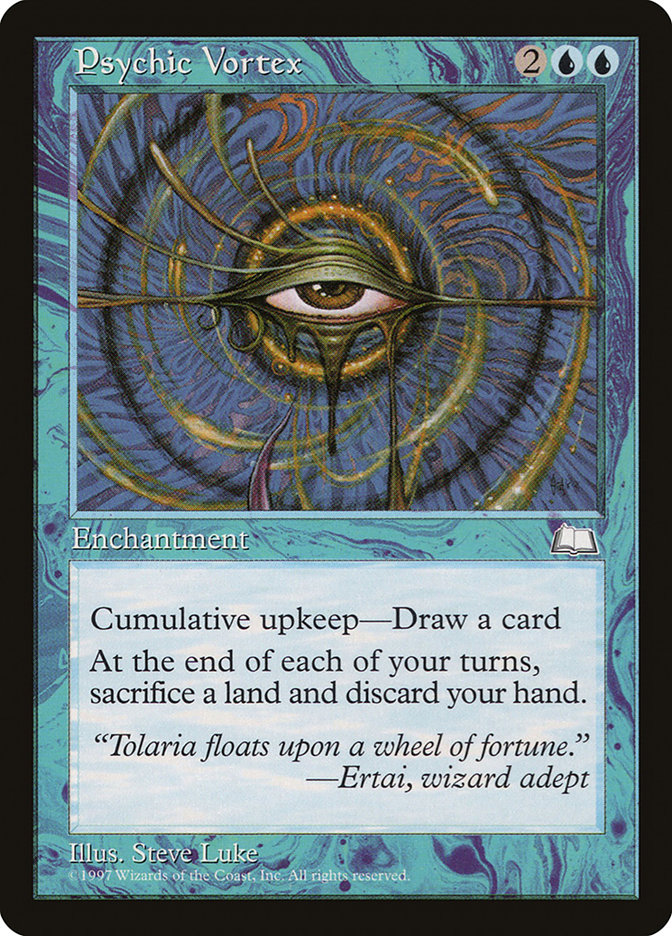 | Psychic Vortex
{2}{U}{U}
Enchantment
Cumulative upkeep—Draw a card.
At the beginning of your end step, sacrifice a land and discard your hand.
“Tolaria floats upon a wheel of fortune.”
—Ertai, wizard adept
| Psychic Vortex is an interesting card that completely changes blue's entire MO. You get to draw as many cards as you want esscentially but you lose access to counter magic and can't net additional land drops.
The interesting thing demonstrated by Psychic Vortex is the desirable action of drawing a card is presented as a cost–one which paid forever accelerates the rate at which you eventually lose the game.
| 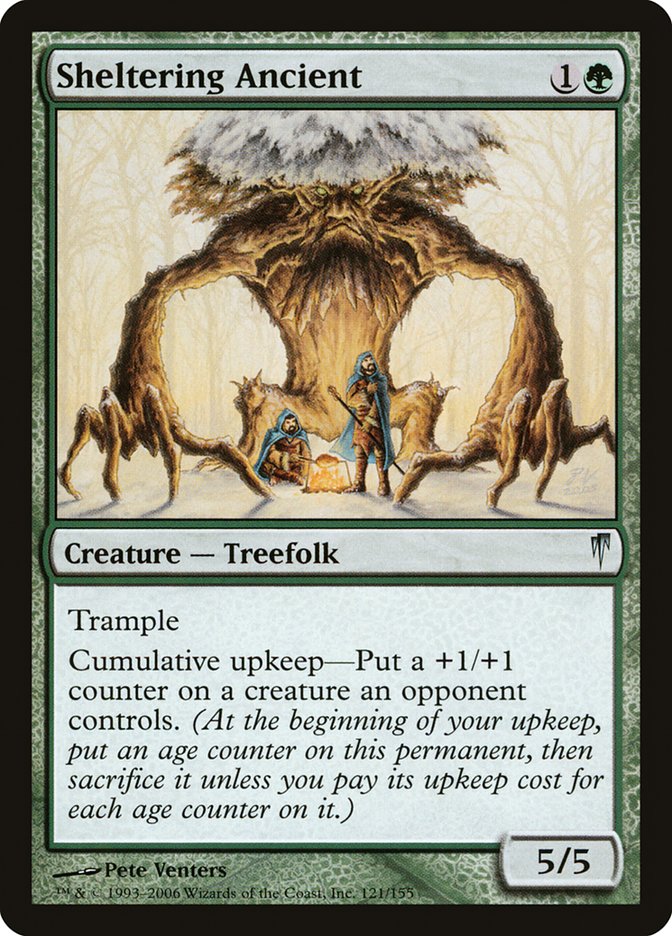 | Sheltering Ancient
{1}{G}
Creature — Treefolk
Trample
Cumulative upkeep—Put a +1/+1 counter on a creature an opponent controls.
5/5 | A nice 5/5 that, again demonstrating the Aboroth principle wherein the card quickly outstrips its value.
| 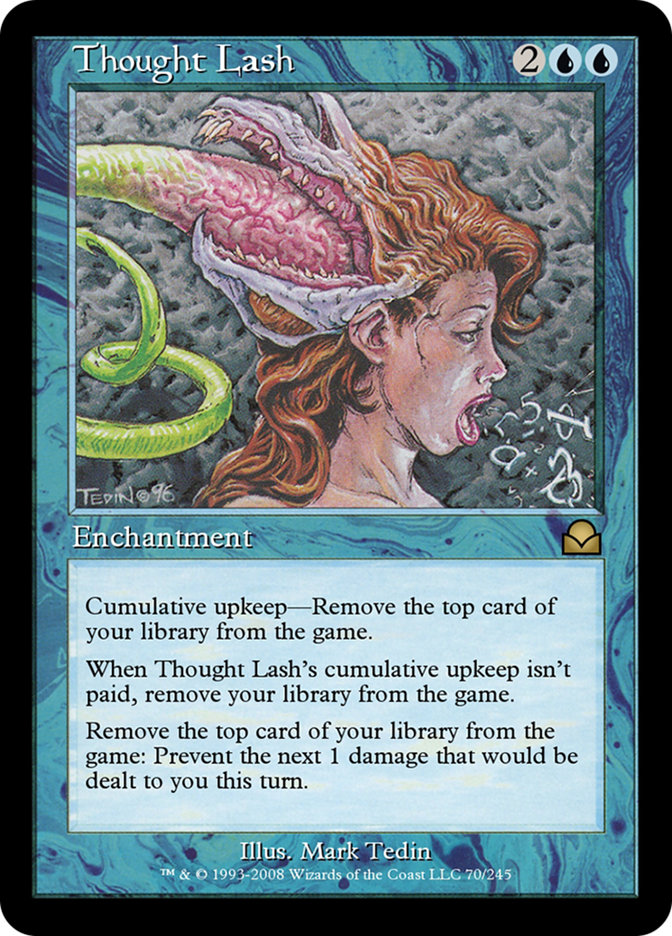
|
Thought Lash
{2}{U}{U}
Enchantment
Cumulative upkeep—Exile the top card of your library.
When a player doesn’t pay Thought Lash’s cumulative upkeep, that player exiles all cards from their library.
Exile the top card of your library: Prevent the next 1 damage that would be dealt to you this turn.
| I don't want to talk about this card and will continue to live my life pretending this weird ass card doesn't fucking exist.
| 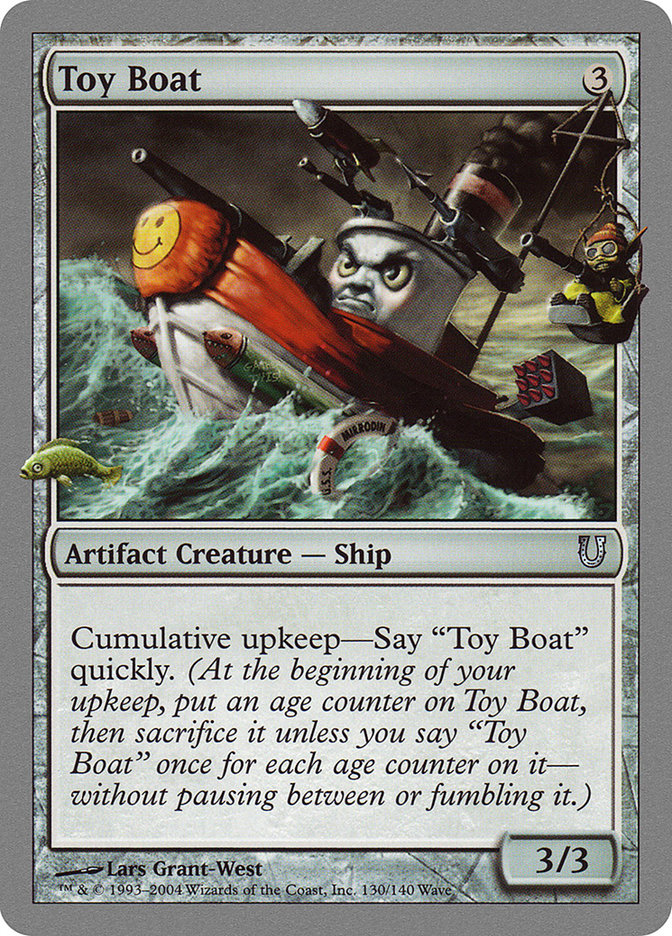 | Toy Boat {3}
Artifact Creature — Ship
Cumulative upkeep—Say “Toy Boat” quickly. (At the beginning of your upkeep, put an age counter on Toy Boat, then sacrifice it unless you say “Toy Boat” once for each age counter on it—without pausing between or fumbling it.)
3/3 | A nice fun Un-card that takes the principles of cumulative upkeep and applies them to the logic of silver borders.
| 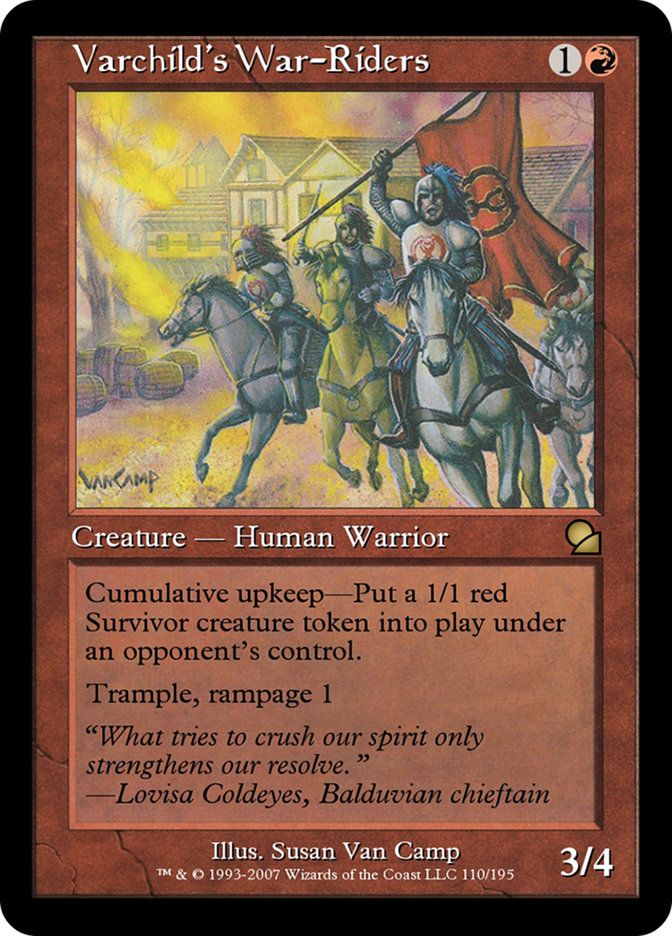
| Varchild's War-Riders
{1}{R}
Creature — Human Warrior
Cumulative upkeep—Have an opponent create a 1/1 red Survivor creature token.
Trample; rampage 1 (Whenever this creature becomes blocked, it gets +1/+1 until end of turn for each creature blocking it beyond the first.)
“What tries to crush our spirit only strengthens our resolve.”
—Lovisa Coldeyes, Balduvian chieftain
3/4 | Here we see the Hunted Cycle changed from an effect into a cost, although if we respect chronology Varchild's War-riders came first.
It like, psychic visions and many other cards in this list, demonstrate a play for actions traditionally considered effects to be used as costs which I think is the biggest strength of cumulative upkeep.
| 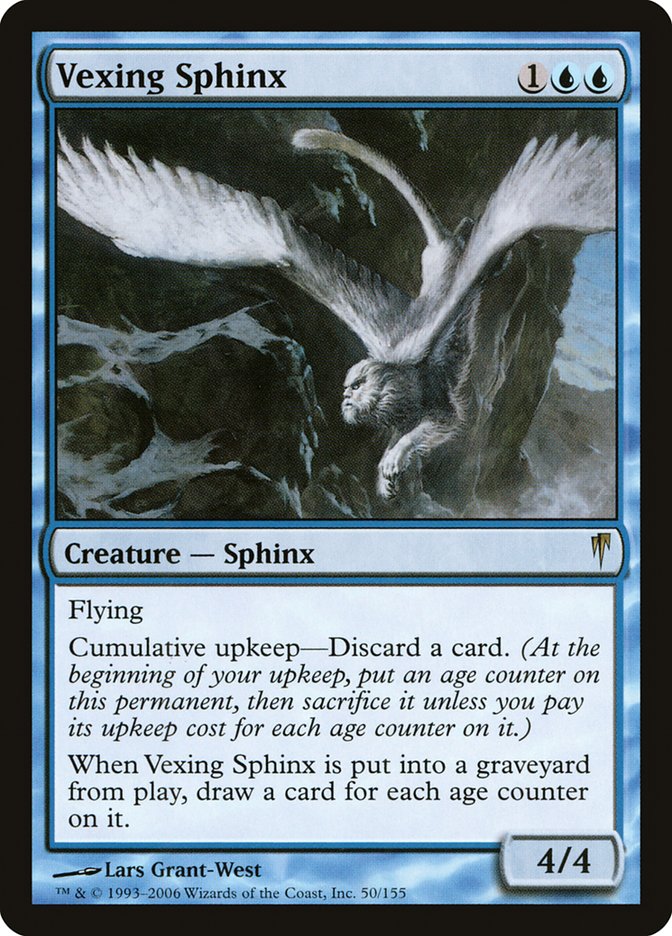 | Vexing Sphinx
{1}{U}{U}
Creature — Sphinx
Flying
Cumulative upkeep—Discard a card.
When Vexing Sphinx dies, draw a card for each age counter on it.
4/4 | Vexing Sphinx, recently reprinted in dominaria remaster, is an example of a card that gets stronger as it ages. You get to draw cards when it eventually dies to your not paying its cost.
The hiccup in the design is that you never gain a net positive with it: at an age of one it replaces itself, at an age of two it replaces itself and the card you discarded last turn, and at an age of three, it net loses you a card.
| 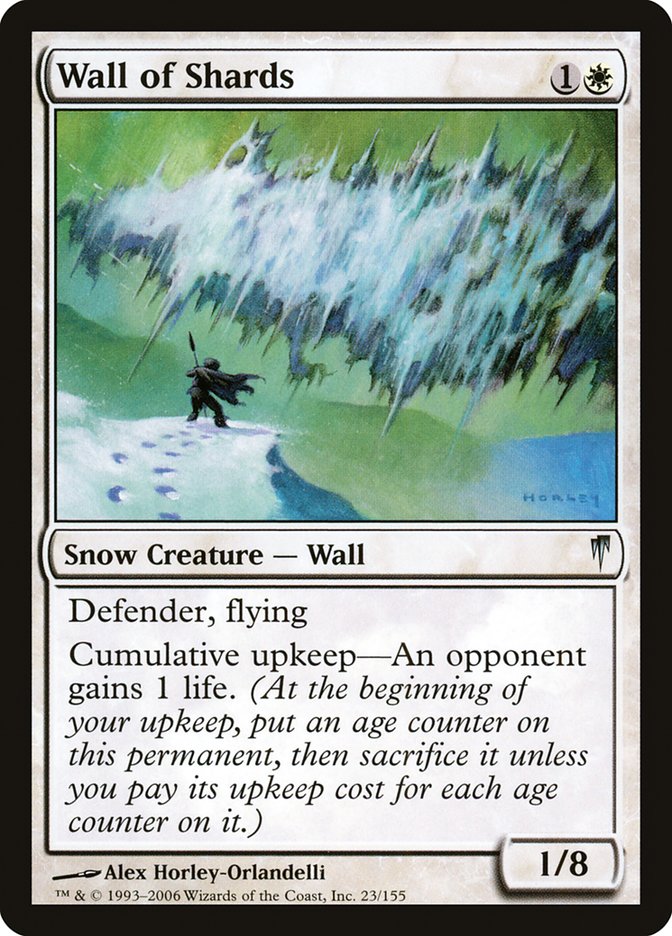 |
Wall of Shards
{1}{W}
Snow Creature — Wall
Defender, flying
Cumulative upkeep—An opponent gains 1 life. (At the beginning of your upkeep, put an age counter on this permanent, then sacrifice it unless you pay its upkeep cost for each age counter on it.)
1/8 | Wall of Shards is a beautifully wierd card from coldsnap that gains your opponent an increasing large amount of life. Why would you want that?
Well, it's a 1/8 blocker for two with flying which is pretty good, but also cards like false cure, rain of gore, and tainted remedy turn that life gained into life lost, and demonstrates another principle of the mechanic:
Later cost quickly dwarf earlier costs. If you play this turn two, and it takes you four turns to find and cast a tainted remedy to change life gained into life lost, your opponent has gained 10 life and in two turns, they'll have lost 11 life, netting a life lose of 1. The next turn, they lose 7 life for a net of -8.
Needlebite trap is also a cute include in such a 'life pain' deck.
|
As you can see, there are a lot of interesting cards that cause you to take actions that you wouldn't normally see as a cost as costs including Braid of Fire, Herald of Leshrac, Jötun Grunt, Varchild's War-riders and Wall of Shards. And dishonorable mentions to Mystic Remora for being annoyingly good enough to see play in commander and Illusions of Grandaur for being a bomb in Zedruu / Harmless Offering decks list. This is the state of cumulative upkeep. It's honestly kinda of a mess.
So, what can be done to make it better? Well, the first thing to admit is that cumulative upkeep isn't ever gonna work as a set defining mechanic. It didn't work in Cold Snap, and I doubt it'll work in sets with good cards either. I also don't think it's a good idea to rely on it as a hard downside mechanic when balancing cards because either those cards are gonna be good enough that you never need to pay their upkeep because you get the value immediately, or their optimal play pattern is going to be the same as Illusions of Grandaur: harmless offering for a net swing of 40 life, or theyr just not going to be any good.
I think cumulative upkeep is a tool best used sparingly as a deciduous mechanic used to bring out interesting and unique ludonarratives, like with Varchild's War-riders, or which can interact interestingly with other cards like wall of shards. It's definitely a niche mechanic best used sparingly, but I think it's more appropriately scored at a 4-5 on the Storm Scale, and it's current 9 is in my eyes a fucking crime.
Example cards: 
| Kigneous, Scorns’ Pyre
Two Generic, Two Red, and a White
Legendary Creature – Demon
Flying
Other creatures have haste, vigilance, and “Cumulative upkeep—Have this creature deal 1 damage to itself and 1 damage to you. If this creature is a Demon or Devil, you may pay 0 instead.”
Creatures get +1/+0 for each age counter on them.
Burn fast, burn bright, burn hot, burn out.
4/3
| Originally made for Counter Mayhem CotW challenge, Kigneous has seen ... some changes, but he continues to give cumulative upkeep to creatures.
The ludonarative here is that he gives the power of his flames to mortals who, unable to bare the burden, lash out hurting themselves and others before burning out entirely; in exchange however theyr granted speed and temporary strength.
| 
| Abandoned Reactor
Five Generic
Artifact
Cumulative upkeep—Gain an Energy.
When you have ten or more energy, sacrifice Abandoned Reactor
When you sacrifice Abandoned Reactor, it deals damage equal to its age to each creature and each player.
“What do you mean you lost the entire reactor?”
| This is a really reliable source of energy for ten upto nine turns before turn ten causes it to go critical. And if you can spend all that energy to get you opponent below the explosion threshhold and yourself above it, well, it's a really good finisher.
Even if you don't use energy in your deck, having a ticking timebomb on the board will cause your opponents to hesitate dedicating resources to their board state.
The interesting ludonarative is a kaladesh reactor forgotten because reasons, keeps providing power to the grid but isn't maintained and eventually goes critical.
| 
| Rosetia of the Bright Bargain
A Green and A White
Legendary Creature — Elf Warlock
Lifelink
Cumulative upkeep—Gain 1 life
Tap: Add a green and a white. Gain life equal to Rosetia's age.
Rosetia's power is equal to zero or your life total minus your starting life total, whichever is greater.
At the beginning of your upkeep, if you have twenty or more life than your starting life total, you lose the game.
*/2
| Mechanically what we see here is a framing of life gain as a potentially undesirable cost as it forces you into a potentially unfavorable situation that can lose the game on the spot.
Ludonaratively, we see the story of a pact with a bright power being just as destructive as a pact with a dark power. Rosetia is through the bargain struck to heal for the betterment of her community using it to heal more than she would otherwise be able too, but it doesn't give her the ability to heal herself, and the pressure of expectations from the being of light she formed a pact with will drive her to overwork herself to death.
If you'll forgive a YuGiOh reference on this, the magic set editor forum, it's similar to season 2 of YuGiOh Gx where the moral of the story is that unmitigated light is just as powerful and all consuming a force as darkness is traditionally portrayed. This is that same sort of idea. Dark powers are destructive yes, but Light powers aren't much better for your long term health. |
These are I think some example cards of how cumulative upkeep can be used in interesting ways. |
|